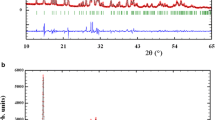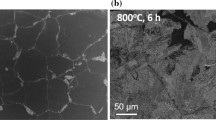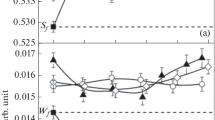Abstract
We consider the specific problem of the influence of an inhomogeneous distribution of defects in solids on positron annihilation characteristics. In detail, we investigate the effect of micro-structure, i.e. dislocations, vacancies, vacancy clusters, grain and subgrain boundaries, pores or inner surfaces, on positron lifetime spectroscopy. Only few materials show such small grain sizes that positron annihilation is affected. One example are powder compacts, made out of small and fine-grained powder, during different stages of the sintering process. All samples generically show positron trapping at grain boundaries (τGB ≈ 300 ps) and at surfaces (τsurf = 500–600 ps). τGB = 300 ps corresponds to small voids consisting of roughly eight vacancies. Different defects can lead to similar annihilation parameters. Hence, we compare the lifetime data obtained from porous and fine-grained samples to the kinetics of defect annealing after irradiation and plastic deformation, e.g. the thermal stability of dislocations or vacancy clusters. We conclude that τGB ≈ 300 ps is apparently not related to vacancy clusters in the matrix, but is due to positron trapping at large-angle grain boundaries. This large open volume is in contrast to common grain boundary models. The change of porosity and grain size with temperature, i.e. during sintering, has been determined in a correlated study by metallography and X-ray line-profile analysis. The effective powder particle size ranges from ≈0.5 to ≈15 μm, while the grain sizes are always smaller. The only detectable lattice defects in all samples above recrystallization temperature are grain boundaries, besides a surface component in very fine powders.
Similar content being viewed by others
References
T. E. M. Staab, R. Krause-Rehberg, B. Vetter and B. Kieback, J. Phys.: Condens. Matter 11(7) (1999) 1757.
T. E. M. Staab, R. Krause-Rehberg, B. Vetter, B. Kieback, G. Lange and P. Klimanek, ibid.11(7) (1999) 1787.
T. E. M. Staab, R. Krause-Rehberg, B. Vetter and B. Kieback, ibid.11(7) (1999) 1807.
A. Seeger, Appl. Phys. 4(1974) 183–199.
B. Bergensen and M. J. Stott, Solid State Commun. 7 (1969) 1203–1205.
D. C. Connors and R. N. West, Phys. Lett. 30A(1) (1969) 24–25.
A. Dupasquier, R. Romero and A. Somoza, Phys. Rev. B48(13) (1993) 9235–9245.
Ch. Hübner, T. Staab and R. Krause-Rehberg, Appl. Phys. A61(1995) 203–206.
M. J. Puska and R. M. Nieminen, J. Phys. F: Metal Phys. 13(1983) 333–346.
Ch. V. Kopetskii, G. I. Kulesko, L. S. Kokhanchuk and O. V. Zharikov, Phys. Stat. Sol. (a) 22(1974) 185–194.
M. L. Johnson, S. Saterlie, D. Boice and J. G. Byrne, ibid.48(1978) 551–554.
T. LeipistÖ, J. Yli-kauppila, P. Kettunen and P. Hautojävrvi ibid.67(1981) K93–K97.
J. G. Byrne, Met. Trans. A. 10A(1979) 791–807.
S. Mantl and W. Triftshäuser, Phys. Rev. B17(4) (1978) 1645–1652.
K. Hinode, S. Tanigawa and M. Doyama, Rad. Effects 32(1977) 73–77.
T. E. M. Staab, K. Petters, C. G. Hübner and A. Polity,Multi-component positron lifetime analysis of the annealing behavior in electron irradiated and plastically deformed highpurity metals (1999) to be published.
B. Somieski, T. E. M. Staab and R. Krauserehberg, Nucl. Instr. and Meth. A381(1996) 128–140.
Idem., Nucl.Instr. Meth. A381(1996) 141–151.
R. M. Nieminen, in edited by W. Brandt and A. Dupasquier, Proceedings of the International School of Physics “Enrico Fermi”—Positron Solid State Physics (North Holland, Amsterdam, 1983) pp. 359–407.
R. Paulin, in edited by W. Brandt and A. Dupasquier, Proceedings of the International School of Physics “Enrico Fermi”— Positron Solid State Physics (North Holland, Amsterdam, 1983) pp. 565–580.
B. Bergensen, E. Pajanne, P. Kubica, M. J. Stott and C. H. Hodges, Solid State Commun. 15(1974) 1377–1380.
T. Mcmullen, in edited by P. C. Jean, R. M. Singru and K. P. Gopinathan “Positron Annihilation” (World Scientific, Singapore, 1985) pp. 822–824.
W. Frank and A. Seeger, Appl. Phys. 3(1974) 61–66.
A. Shukla, M. Peter and L. Hoffmann, Nucl. Instr. Meth. A335(1993) 310–317.
Y. C. Jean, F. Zandiehnadem and Q. Deng, Mat. Sci. Forum 105–110(1992) 1897–1900.
G. Dlubek, O. Brümmer and P. Sickert, Kristall und Technik 12(3) (1977) 295–306.
K. Hinode, S. Tanigawa and M. Doyama, J. Phys. Soc. Japan 41(6) (1976) 2037–2042.
J. E. Kluin and Th. Hehenkamp, Phys. Rev. B44(11) (1991) 597–608.
R. M. Nieminen and J. Laakkonen, Appl. Phys. 20 (1979) 181–184.
K. G. Lynn, W. E. Frieze and P. J. Schultz, Phys. Rev. Lett. 52(13) (1984) 1137–1140.
R. Steindl, G. KÖgel, P. Sperr, P. Willutzki, D. T. Britton and W. Triftshäuser, Mater. Sci. Forum 105–110(1992) 1455–1458.
R. M. Nieminen, M. J. Puska and M. Manninen, Phys. Rev. Lett. 53(13) (1984) 1298.
M. J. Puska and R. M. Nieminen, Rev. Mod. Phys. 66(3) (1994) 841–897.
J. Wolff, M. Franz and Th. Hehenkamp, Mater. Sci. Forum 175–178(1995) 569–572.
H. E. Schaefer, Phys. Stat. Sol. (a) 102(1987) 47–65.
E. Soininen, H. Huomo, P. A. Huttunen, J. Mäkinen, A. Vehannen and P. Hautojärvi, Phys. Rev. B41(10) (1990) 6227–6233.
P. J. Schultz and K. G. Lynn, Rev. Mod. Phys. 60(3) (1988) 701–79.
H. Gleiter, Mater. Sci. Eng. 52(1982) 91–131.
W. Brandt and R. Paulin, Phys. Rev. Lett. 21(4) (1968) 193–195.
A. Gainotti and C. Ghezzi, 24(8) (1970) 349–351.
G. Gottstein, “Einführung in die allgemeine Metallkunde und in die Werkstoffwissenschaften,” Lecture Script RWTH (Aachen, Aachen, Germany, 1984).
C. G. Hübner, T. Staab and H. S. Leipner, Phys. Stat. Sol. (a) 150(1995) 653–660.
Th. Hehenkamp, Th. Kurschat and W. Lührtanck, J. Phys. F Metal Phys. 16(1986) 981–987.
K. O. Jensen, J. Phys.: Condens. Matter 1(1989) 10,595–10,602.
M. J. Puska, ibid. 3(1991) 3455–3469.
P. A. Sterne and J. H. Kaiser, Phys. Rev. B43(17) (1991) 13,982–13,998.
A. Saoucha, N. J. Pedersen and M. Eldrup, Matter. Sci. Forum 105–110(1971, 1992).
G. Dlubek, O. Brümmer, N. Meyendorf, P. Hautojärvi, A. Vehanen and J. Yli-kauppila, J. Phys. F: Metal Phys. 9(10) (1979) 1961–1973.
G. Dlubek, R. Krause, O. Brümmer, Z. Michno and T. Gorecki, ibid.17(1987) 1333–1347.
M. J. Fluss, L. C. Smedskjaer, R. W. Siegel, D. G. Legnini and M. K. Chason, ibid.10(1980) 1763–1774.
N. Q. Lam, L. Dagens and N. V. Doan, ibid.13(1983) 2503–2516.
P. Ehrhart and U. Schlagheck, ibid.4(1974) 1575–1588.
Idem., ibid.4(1974) 1589–1598.
W. Wycisk and M. Feller-kniepmeier, Phys. Stat. Sol. (a) 37(1976) 183–191.
T. Troev, Ch. Angelova and I. Mincov, Phys. Lett. A138(1, 2) (1989) 65–68.
L. C. Smedskjaer, M. J. Fluss, D. G. Legnini, M. K. Chason and R. W. Siegel, J. Phys. F: Metal Phys. 11(1981) 2221–2230.
D. Hull and D. J. Bacon, “Introduction to Dislocations,” 3rd ed. (Pergamon Press, Oxford, New York, 1984).
F. R. N. Nabarro, “Theory of Crystal Dislocations” (Oxford University Press, Oxford, 1976).
R. Myllylä, M. Karras and T. Miettinen, Appl. Phys. 13(1977) 387–389.
B. Somieski, PhD thesis, Technische Fakultät der Universität des Saarlandes und Martin-Luther Universität Halle-Wittenberg, Fr.-Bach-Platz 6, 06108 Halle/Saale, Germany, 1996.
A. Seeger, Theorie der Gitterfehlstellen, in edited by S. Flügge “Handbuch der Physik-Kristall-physik 1-Bd.4 Teil 1” (Springer, Berlin, 1955), pp. 383–667.
W. Schatt and M. Hinz, Powder Metall. internat. 20(6) (1988) 17–20.
R. Krause, W. Schatt, B. Vetter and A. Polity, Cryst. Res. Technol. 25(7) (1990) 819–825.
B. Vetter, PhD thesis, Fakultät für Maschinenwesen, Technische Universität Dresden, Helmholtzstr. 7, D-01069 Dresden, Germany, 1991.
K. Brand, PhD thesis, Fakultät für Maschinenwesen, Technische Universität Dresden, Helmholtzstr. 7, D-01069 Dresden, Germany, 1993.
Author information
Authors and Affiliations
Rights and permissions
About this article
Cite this article
Staab, T.E.M., Krause-Rehberg, R. & Kieback, B. Review Positron annihilation in fine-grained materials and fine powders—an application to the sintering of metal powders. Journal of Materials Science 34, 3833–3851 (1999). https://doi.org/10.1023/A:1004666003732
Issue Date:
DOI: https://doi.org/10.1023/A:1004666003732




